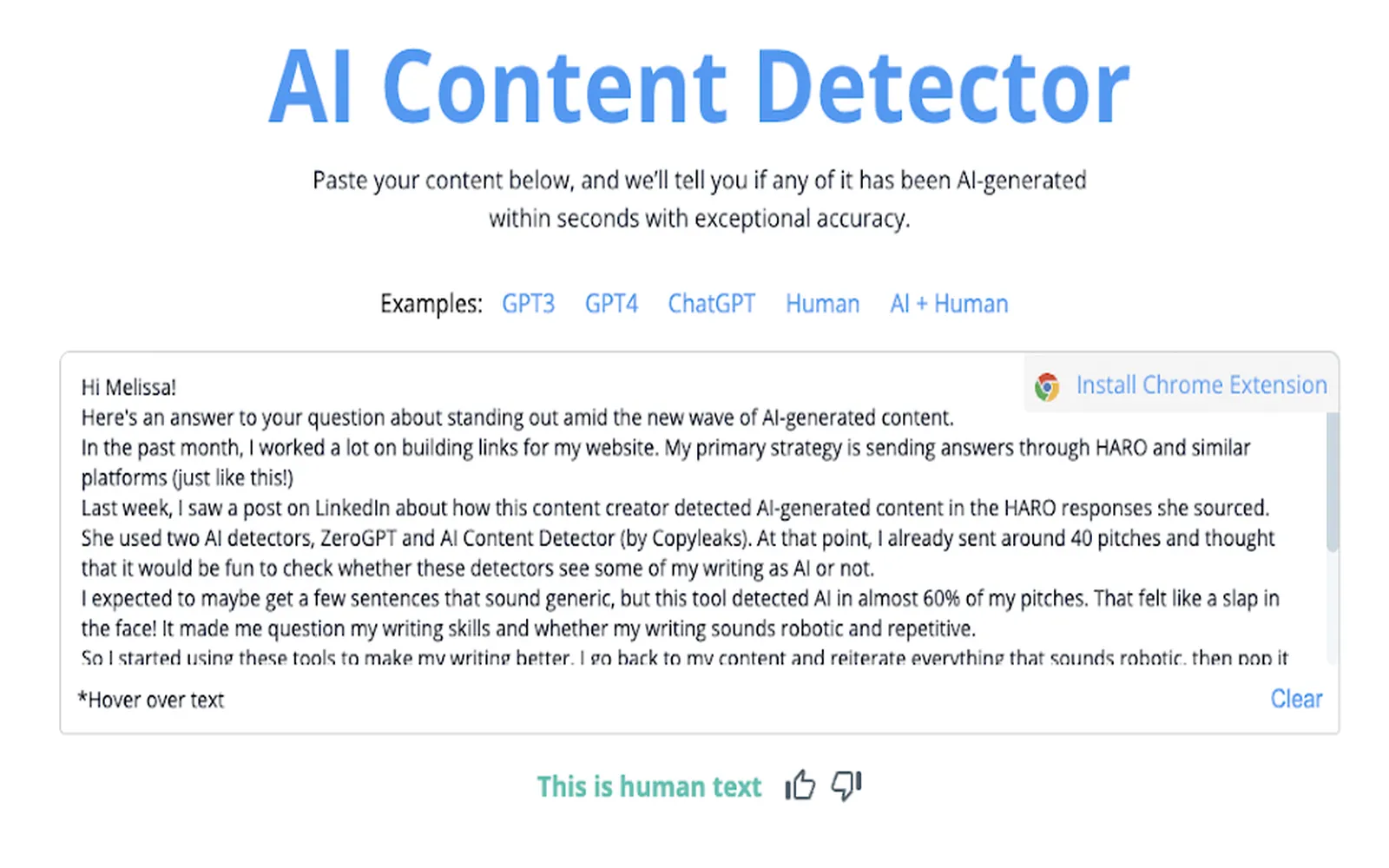
Business growth
Business growth refers to the process of improving a company's success and profitability through various strategies, including expanding market reach, increasing sales, enhancing operational efficiency, and innovating products or services. It involves strategic planning and execution to achieve long-term sustainability and competitiveness in the marketplace.

Using AI for blog writing: Here's what happened when I used AI to write a blog post
In this exploration of AI-assisted blog writing, I experimented with an AI tool to generate a complete blog post. The experience revealed both the strengths and limitations of AI in crafting engaging content. While the AI produced coherent text and offered fresh ideas, it sometimes lacked the personal touch and nuanced understanding of complex topics. Ultimately, this experiment highlighted the potential of AI as a valuable writing aid, while also emphasizing the importance of human oversight in the creative process.

Brand journalism: What is it and what can it do for your brand?
Brand journalism is a strategic approach that combines storytelling with journalism to create engaging content that reflects a brand's values and mission. By producing high-quality articles, videos, and other media, brands can build trust and credibility with their audience. This method not only enhances brand visibility but also fosters deeper connections with consumers, encouraging loyalty and engagement. Ultimately, brand journalism serves as a powerful tool for communicating a brand's narrative while providing valuable insights and information to its target audience.

6 ways to make your content stand out in the AI writing wave
In a landscape dominated by AI-generated content, it's crucial to differentiate your work. Focus on authenticity by infusing your unique voice and perspective into your writing. Utilize storytelling techniques to engage readers emotionally, creating a memorable connection. Incorporate visuals and multimedia elements to enhance the user experience. Emphasize in-depth research and expert insights to build credibility. Tailor your content for specific audiences, addressing their needs and interests. Lastly, encourage interaction through questions and calls to action, fostering community engagement.

How AI makes me a better blog writer
AI enhances my blog writing by providing insightful suggestions and generating creative ideas that inspire fresh content. It helps me refine my language and tone, ensuring my posts resonate with readers. With grammar and style checks, I can maintain professionalism while focusing on my message. Additionally, AI analyzes trends and audience preferences, allowing me to tailor my topics for better engagement. Overall, these tools streamline my writing process and elevate the quality of my blog.

5 Google Ads tips to get the most out of your advertising campaigns
Maximizing your Google Ads campaigns involves a strategic approach to ensure optimal performance. Start by conducting thorough keyword research to target the right audience effectively. Craft compelling ad copy that highlights unique selling points and includes a clear call to action. Utilize ad extensions to provide additional information and improve visibility. Regularly analyze performance metrics to refine your strategy and allocate your budget wisely. Lastly, consider A/B testing different ad variations to identify what resonates best with your target market.

8 ways real businesses are using AI for content creation
Businesses are increasingly leveraging AI to enhance content creation in various innovative ways. They utilize AI-driven tools for generating blog posts, social media content, and personalized marketing materials, streamlining their workflows. Additionally, AI algorithms analyze audience engagement data to optimize content strategies. Companies also employ AI for video production, graphic design, and automated copywriting, enabling them to produce high-quality content quickly. This integration of AI not only boosts efficiency but also allows for more tailored and engaging customer experiences.

The curse of bad data on your marketing content
Bad data can severely undermine marketing content, leading to misguided strategies and ineffective campaigns. When inaccurate or outdated information influences decision-making, brands risk alienating their audience and missing key opportunities. Poor data quality can result in misaligned messaging, wasted resources, and diminished trust among consumers. Ultimately, relying on flawed data not only hampers engagement but also jeopardizes brand reputation, making it essential for marketers to prioritize data accuracy and integrity in their content creation efforts.

Programmatic SEO: How to increase search traffic with no-code tools
Programmatic SEO leverages automation and data-driven strategies to enhance search traffic without the need for extensive coding knowledge. By utilizing no-code tools, marketers can efficiently generate and optimize large volumes of web pages tailored to specific keywords and user intents. This approach allows for rapid scaling of content creation, ensuring that websites remain relevant and competitive in search rankings. With a focus on streamlined processes and user experience, programmatic SEO empowers businesses to attract organic traffic effectively and sustainably.

How to grow a newsletter: 5 ways to scale your newsletter without paid ads
Growing a newsletter organically involves several effective strategies. Start by creating high-quality, engaging content that resonates with your audience, encouraging them to share it with others. Leverage social media platforms to promote your newsletter and connect with potential subscribers. Collaborate with other creators or influencers to reach new audiences through guest posts or joint promotions. Implement referral programs that incentivize current subscribers to refer friends. Finally, optimize your sign-up process to make it easy and appealing for new subscribers to join.

What is marketing resource management (MRM)?
Marketing Resource Management (MRM) refers to the processes and tools that help organizations manage their marketing resources efficiently. It encompasses planning, budgeting, and workflow management, enabling teams to optimize the use of assets such as content, campaigns, and budgets. MRM solutions streamline collaboration among marketing teams, enhance visibility into resource allocation, and improve overall productivity. By providing a centralized platform for managing marketing activities, MRM helps organizations achieve their goals more effectively while maximizing return on investment.

Pains and gains: How to give your customers what they want
"Pains and gains: How to give your customers what they want" explores the essential practice of understanding customer needs by identifying their pain points and desires. By analyzing their challenges and aspirations, businesses can tailor products and services to better meet expectations. This approach fosters stronger customer relationships, enhances satisfaction, and drives loyalty. Ultimately, the focus is on aligning offerings with customer experiences, ensuring that businesses not only address existing issues but also anticipate future needs for sustainable growth.

Omnichannel marketing 101: What it is and why it matters
Omnichannel marketing refers to creating a seamless customer experience across multiple channels, including online and offline platforms. This approach integrates various touchpoints, ensuring that customers can interact with a brand consistently, whether through social media, email, or in-store visits. The significance of omnichannel marketing lies in its ability to enhance customer engagement, improve brand loyalty, and increase sales by providing a personalized and cohesive experience. By understanding customer behavior across channels, businesses can effectively tailor their strategies and drive better results.

19 marketing channels: How to choose the right ones—and leverage them effectively
Understanding the diverse range of marketing channels is crucial for businesses aiming to maximize their reach and impact. This guide explores 19 distinct marketing channels, providing insights on how to select the most suitable ones for your brand's goals. It emphasizes the importance of aligning your choices with target audience preferences and industry trends. Additionally, effective strategies for leveraging these channels are discussed, ensuring that businesses can optimize their marketing efforts and achieve better engagement and conversion rates.

How to conduct your own market research survey (with example)
Conducting your own market research survey involves defining your objectives and identifying your target audience. Start by crafting clear and concise questions that align with your goals, using a mix of open-ended and closed-ended formats. Distribute the survey through appropriate channels, such as social media or email, to reach your audience effectively. For example, a local coffee shop might ask customers about their beverage preferences and desired atmosphere. Analyze the collected data to gain insights that can inform your business decisions.

How to create a Facebook ad strategy (with template)
Creating a Facebook ad strategy involves understanding your target audience, setting clear goals, and determining your budget. Start by defining your objectives, whether it's increasing brand awareness, driving traffic, or generating leads. Research your audience demographics and interests to tailor your messaging effectively. Utilize A/B testing to refine your ad content and visuals based on performance. Finally, monitor your campaign results regularly to optimize for better results. A template can help streamline this process, ensuring consistency and focus in your advertising efforts.

eCommerce email marketing: Strategies and tips for success
eCommerce email marketing is a powerful tool for driving sales and building customer relationships. Successful strategies include segmenting your audience to deliver personalized content, crafting compelling subject lines to boost open rates, and utilizing automated campaigns for timely engagement. Additionally, integrating clear calls to action and visually appealing designs can enhance user experience. Regularly analyzing performance metrics allows for ongoing optimization, ensuring that your campaigns remain effective and relevant in a competitive digital landscape.

Content marketing AI: How artificial intelligence is changing the game
Content marketing AI is revolutionizing the way brands create and distribute content. By leveraging advanced algorithms and data analytics, businesses can now tailor their messaging to specific audiences with unprecedented precision. AI tools assist in generating insights about consumer preferences, optimizing content for search engines, and even crafting compelling narratives. This technological shift not only enhances efficiency but also allows for more personalized and engaging interactions, ultimately driving better results and fostering stronger connections between brands and their customers.

Generate new content ideas from your meeting transcripts
Utilizing meeting transcripts can be a powerful way to generate fresh content ideas. By analyzing the discussions, key themes, and insights shared during meetings, you can uncover topics that resonate with your audience. This approach not only helps in creating relevant content but also ensures it is aligned with current organizational goals and challenges. Moreover, tapping into the collective knowledge of your team fosters collaboration and enhances creativity, leading to diverse and engaging content opportunities.

What is a squeeze page? And does your business need one?
A squeeze page is a focused landing page designed to capture visitors' contact information, typically through an email subscription form. It aims to convert traffic into leads by offering valuable content or incentives in exchange for personal details. Businesses can benefit from a squeeze page by building a targeted email list, facilitating direct communication with potential customers, and enhancing marketing efforts. Ultimately, if your business seeks to grow its audience and improve conversion rates, a squeeze page can be a valuable tool.

14 smart eCommerce personalization strategies and examples
Effective eCommerce personalization strategies enhance customer experience and drive sales by tailoring interactions to individual preferences. Techniques such as personalized product recommendations, dynamic content based on user behavior, and targeted email campaigns can significantly boost engagement. Examples include utilizing browsing history to suggest relevant items, creating tailored landing pages, and offering exclusive discounts based on purchase history. These strategies not only foster customer loyalty but also improve conversion rates, making personalization a crucial aspect of successful online retail.